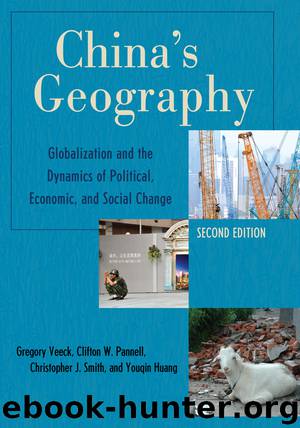China's Geography by Gregory Veeck

Author:Gregory Veeck [Veeck, Gregory]
Language: eng
Format: epub
Publisher: Rowman & Littlefield Publishing Group, Inc.
Published: 2011-06-14T16:00:00+00:00
Structural Shift and Spatial Outcomes
Structural shift or change of China’s economy was put in motion during the early stages of communist rule in 1952. However, the pace of the change was muted and modest owing to erratic policies, political events, and related economic performance. This is evident in the slow pace of the shift in farmworkers to nonfarm activities in the period 1952–1975 (see table 7.2). The reforms of 1978 accelerated the structural shift. This shift may be tracked in two simple ways. One way is to consider the structure of production or output by comparing the percentage share of production attributed to different sectors of the economy. A glance at table 7.3a indicates a continuing decline in the share of the value of output accounted for in the primary sector, mainly agriculture, of the economy since 1985, to the point where this sector accounted for only 11.3 percent of the value of China’s total production by 2008. The share of China’s working population in agriculture has dropped sharply in the past decade, and by 2008, only about 40 percent of the workforce continues to work in this sector (see table 7.3b and figure 7.1). While the decline is striking, nonetheless there were in 2008 still over 306 million workers in the primary sector, a matter that is taken up later in this chapter as we discuss the importance of the primary sector of the economy in absorbing labor.
Download
This site does not store any files on its server. We only index and link to content provided by other sites. Please contact the content providers to delete copyright contents if any and email us, we'll remove relevant links or contents immediately.
China Rich Girlfriend by Kwan Kevin(4470)
The Silk Roads by Peter Frankopan(4424)
Annapurna by Maurice Herzog(3407)
Full Circle by Michael Palin(3359)
Hot Thai Kitchen by Pailin Chongchitnant(3284)
Okonomiyaki: Japanese Comfort Food by Saito Yoshio(2666)
The Ogre by Doug Scott(2611)
City of Djinns: a year in Delhi by William Dalrymple(2493)
Photographic Guide to the Birds of Indonesia by Strange Morten;(2472)
Vietnam, Cambodia, Laos & Northern Thailand by Lonely Planet(2367)
Tokyo by Rob Goss(2353)
Tokyo Geek's Guide: Manga, Anime, Gaming, Cosplay, Toys, Idols & More - The Ultimate Guide to Japan's Otaku Culture by Simone Gianni(2299)
Everest the Cruel Way by Joe Tasker(2223)
Discover China Travel Guide by Lonely Planet(2154)
Iranian Rappers And Persian Porn by Maslin Jamie(2141)
China (Lonely Planet, 11th Edition)(2081)
Lonely Planet China(2072)
Top 10 Dubai and Abu Dhabi by DK Travel(2043)
China Travel Guide by Lonely Planet(2040)
